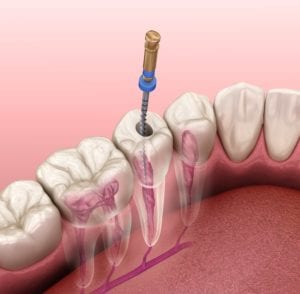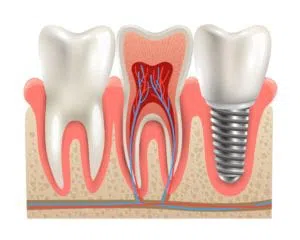When many people feel the sudden, deep pain of a pulp infection, they automatically assume that they will need a root canal. While it is certainly true that pulp infections do require prompt dental treatment to remove the infection, a root canal is no longer the only option. In fact, dental implants are another treatment that can be used when a pulp infection is present. However, root canals and dental implants are very different from one another. Even though they can both alleviate a pulp infection, their differences will help you to determine which treatment is best suited for you.

Root Canal
A root canal preserves your natural tooth while removing the infection from the inside. This is accomplished by making a small access hole in the top or side of your tooth. Then, an assortment of root canal files are used to remove the decayed tissue from the pulp chamber and root canals. Once the chamber and root canals are empty, they will be cleaned to prevent future infection. The inside of the tooth will be filled with gutta-percha, a rubber-like material, to provide stability. The access hole will be filled with composite resin, then the entire tooth will be restored using a dental crown.
In addition to the benefit of preserving the natural tooth, root canals also provide a quick and affordable way to eliminate a pulp infection when compared to dental implants. In most cases, the entire process from root canal to having a dental crown placed takes about 2-3 dental appointments. The cost is often less than that of dental implant placement as well.
Dental Implants

Dental implants are used to replace the infected tooth entirely. This means that the infected tooth will be extracted and then a dental implant will be placed into the jawbone under the empty socket. A metal post used as a connector will then be screwed into the implant and later used to hold a dental crown. Once in place, the implant will fuse with the surrounding bone to act as an artificial tooth root for an implant-supported crown. Although it is not a natural tooth, an implant-supported crown resembles natural teeth, while also maintaining similar function.
Despite the fact that dental implants require a minor oral surgery and have a longer recovery period, they still offer numerous benefits. For starters, replacing an infected tooth with a dental implant completely eliminates the chances of the tooth becoming infected again. This means that there will be no need for a second root canal or other endodontic procedures. Not to mention the fact that dental implants have an almost guaranteed success rate, especially compared to root canals which have been known to fail. Finally, the results associated with dental implant placement will last longer than those from having a root canal.
Overall, both root canals and placing dental implants are satisfactory options for dealing with a tooth affected by a pulp infection. Each method does offer its own approach, and one approach may be better than another, depending on the situation. Discussing these options with your dentist can provide you with more insight as to whether one treatment is right for you in comparison to the other.



